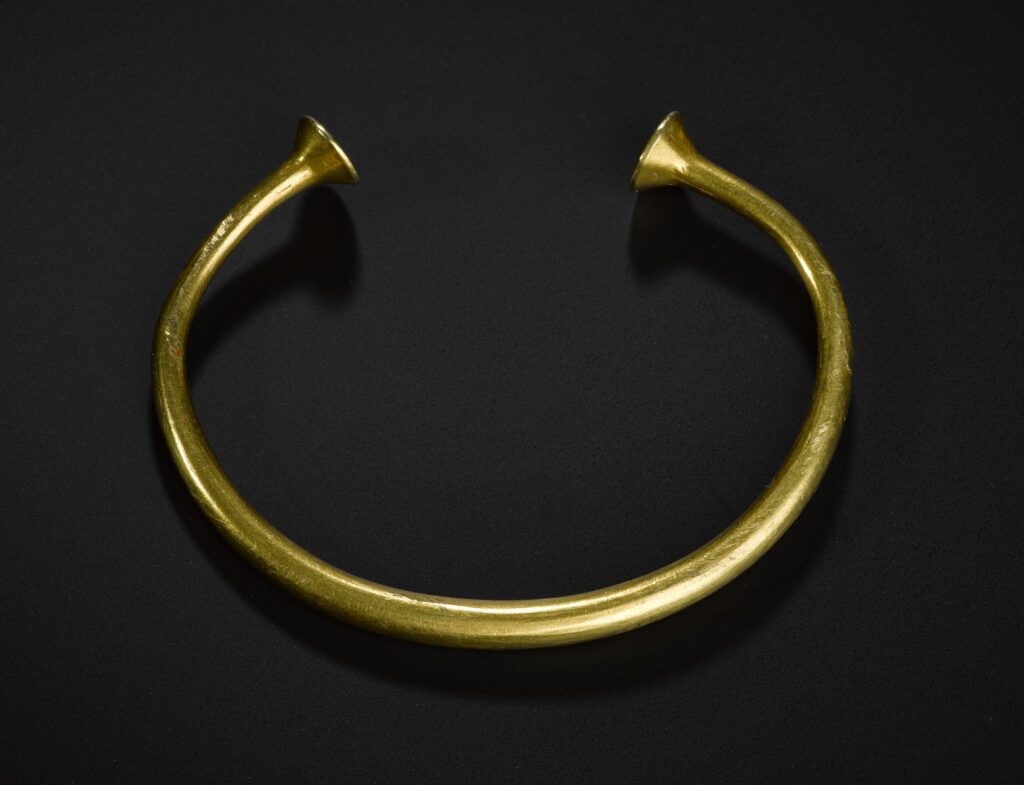Susan Kruse
In the 1960s, several gold objects were ploughed up in a field on marginal land at the Heights of Brae, near Dingwall (MHG8921). Originally mistaken for brass horse fittings, they were drawn to the attention of the National Museum of Antiquities in 1979, and the area was then excavated. The surviving pieces of the hoard comprise three cup-ended ornaments, five penannular armrings and a corrugated gold band. Two other objects are known to have been lost before the excavation.
Such objects are known as single finds and in hoards from Scotland and have Irish parallels, pointing to a date in the Late Bronze Age c. 1000–800 BC. The majority of the Heights of Brae objects are unfinished, suggesting that they were either imported from Ireland in that state, the work of Irish craftsmen in the area, or that they were high-calibre native copies. Long-standing Irish connections in this area are well known, including the discovery that the Early Bronze Age male buried at Culduthel accompanied by archery equipment (including gold rivets on the bracer) was from Ireland (Parker Pearson et al 2019, 395).



The cup-ended ornaments, thought perhaps for use in fastening cloaks, have been found mainly on the west coast. A unique example made from copper alloy formed part of the very early Iron Age Poolewe hoard. This shows a local fascination with this type of ornament which was attempted (with more difficulty) in bronze (Case study Poolewe hoard; Knight et al 2021). Examples of the armlets have been found throughout Scotland; in the Highland Region pairs were found in Caithness and Lochaber. However, the band is without parallel.
If the objects were traded, rather than manufactured locally, they would probably have arrived via the Great Glen. XRF analysis of the objects has been undertaken, and future research involving lead isotopic analysis may help identify from where the gold originated. However, as noted above, an Irish provenance for the gold, does not necessarily mean Irish production.
The objects were clearly possessions of a wealthy individual or community but it remains unclear whether they were buried for safekeeping or religious reasons. Unlike some other Bronze Age hoards, there was no obvious landmark marking the place of deposition. The hoard was found in a prehistoric landscape, with a Neolithic chambered cairn and a number of large roundhouses and field systems nearby. This area appears to have been without much settlement from at least the AD 1500s until its re-settlement by crofters around AD1800. As such, the area has potential for landscape studies, where on the basis of this find, the homes of high-status natives may well be preserved.
Further information
Clarke, D V and Kemp, M M B 1984 ‘A hoard of late Bronze Age gold objects from Heights of Brae, Ross and Cromarty District, Highland Region’, Proc Soc Antiq Scot 114, 189–198.
Coles, John 1960 ‘Scottish Late Bronze Age metalwork: typology, distributions and chronology’, Proc Soc Antiq Scot 93 (1959–1960), 16–134.

 Case study:
Case study: